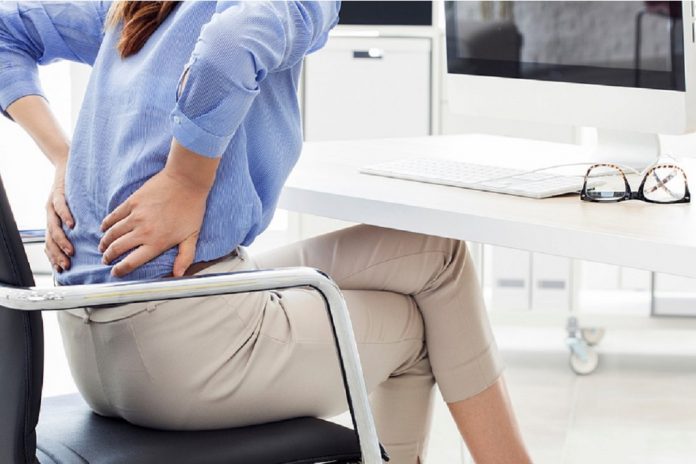by Niamh Pentony, Ergonomist and Director at Boyne Ergonomics
If recent virtual DSE assessments have shown me anything, it is that many employees are still not sure what they need to set up a DSE workstation.
In this article, I will cover the basic essentials every DSE worker should have, both in the office and at home. These are the pieces of equipment that you need to get yourself into a neutral and supported posture at the workstation. I will also cover other equipment, the desirables, that I have found help to reduce the negative impact of DSE work when working from home.
Your DSE Essentials:
Your Work Surface
This may seem obvious, but not every desk or every table is suitable for use as a DSE workstation. Some surfaces, especially those that have not be designed to be used as DSE workstations can be too shallow, have support beams and drawers underneath that impact posture or are too high to be used seated but too low for use standing.
The surface that you choose to use for your workstation should meet the following criteria:
Stable – it does not wobble or shake when you type, the legs are firmly attached and it can take the weight of your equipment
Has appropriate depth – It is deep enough to allow you to place your screen at least arm’s length from your seated position. It is deep enough to accommodate your monitor (external monitor or laptop on riser) and your keyboard in front of your seated position. It is deep enough to allow you to place your legs under the surface without your knees coming in contact with a wall or barrier.
Has appropriate width to accommodate your screens and any other equipment that you use frequently for work.
Has appropriate clearance space underneath between your thighs and the desk surface, or support beam.
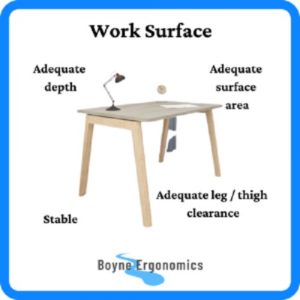
Characteristics of an ideal DSE work surface
Your Chair
Ideally, and legally depending on where you are based, if you are working at a DSE workstation you should have a chair that can be adjusted in height, with a tilt adjustable backrest and height adjustable backrest or lumbar support. These are the basic adjustments needed, not taking in to consideration any special requirements.
However, usually for space reasons, not everyone can accommodate an office chair in their home work area. Many have to try and make do with the seating that they have.
Any seating being used should be at the appropriate height to allow you to be seated with your elbows level with the workstation surface and should support your lower back when you are seated upright in your typing posture.
If you cannot accommodate an office chair, be sure to adapt the chair you have with additional cushioning to improve support and posture.
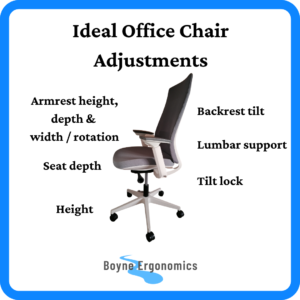

Characteristics of ideal DSE seating
The desk and chair make up the bones of your workstation. Now to pad it out with your accessories.
Your Screen
All DSE workstations have a screen, the clue is in the name!
The screen you are using, laptop, tablet or external monitor, should be positioned at arm’s length from your seated position, at a height that allows you to look at the top third of the screen while your head is facing forward.
If you are using a laptop or tablet, use a riser to safely elevate it to the appropriate level.


Display screen positioning
Your Inputting Devices
When in the office, your workstation will be equipped with a keyboard and mouse but this is not a given when you are working from home.
If you are using a laptop or tablet, once you elevate it to the appropriate height, it is no longer practical or recommended to continue to use them to input data.
Using an external keyboard and mouse will allow you to sit back in you seat, with the inputting devices close to you when the screen is at the appropriate height.
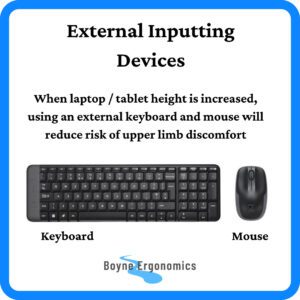

Basic external inputting devices
These essentials will allow you to adopt appropriate postures at the workstation, reducing the risk of musculoskeletal strain and injury.
Your DSE Desirables:
Your Wireless Headset / Earbuds
With virtual meetings tying so may of us to the desk, using a wireless headset is a great way to encourage more mobility in your day. If you have back-to-back meetings or if your meeting is going be more than 45 minutes long, use the wireless headset, turn off your camera and get up and walk around the room for a couple of minutes during the call. This will reduce static loading and muscular strain, boost respiratory and circulatory function and give your eyes a break from the screen.
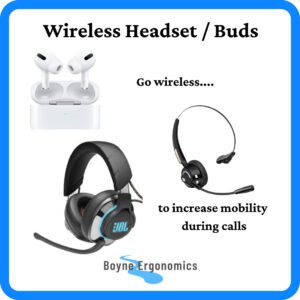

Wireless headphones
Your Footrest
Footrests are not just for us vertically challenged DSE users! They can be a great way to improve stability and circulation when seated, once it is not so tall that it lifts your knees higher than your hips.
It does not have to be a conventional office footrest. A yoga brick or foam roller can work really well too.


Footrests / Alternative footrests
Additional Back Support
A foam back support is a great way to get additional support when you are seated at the workstation, especially if using a dining chair or if you do not feel that your current seat does not provide enough support for your lower back.
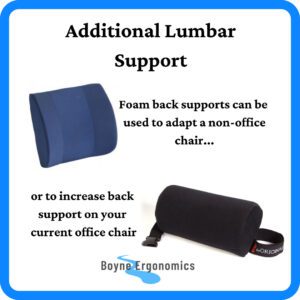

Additional back support
Mobile Phone Stand
For most of us, the phone itself has become an additional screen when we are at the desk.
Elevating it from the desk on a stand reduce your risk of neck strain when using the phone.
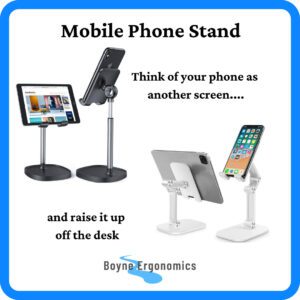

Mobile phone stand
Combined Document Holder & Writing Slope
A common issue with DSE users that work off paper-based documents as well as the monitors is poor posture caused by the positioning of the documents and the keyboard.
A combined document holder and writing slope allows for improved positioning of documents, both when reading and writing, without impacting keyboard position. They are a very useful tool for improving posture but can take up a lot of surface area and so are only usually suitable for desks 700mm+ in depth.
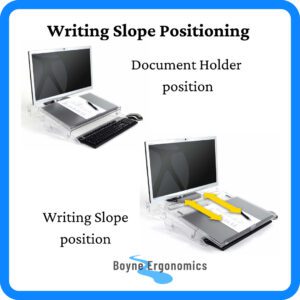

Combined Document Holder & Writing Slope
Every DSE user should have the essentials, these are the very basic pieces of equipment that can help prevent adverse postures and the associated risk of musculoskeletal injury.
It is important to remember though that there is no piece of equipment that replaces the benefit of frequent microbreaks and movement from the workstation (a wireless headset will facilitate it though!).
This is why I did not include a sit stand desk or adaptor in my list of desirables. I believe that they have their uses and are of a benefit to certain groups of DSE users.
However, for the general population, there is a greater benefit to overall health to be had by leaving the workstation frequently, removing yourself from chair, desk, keyboard, mouse and screen, giving your whole body a break from static postures and boosting your circulatory and respiratory system.
Using a break reminder app on your phone can be a great way to kick start the microbreak habit. Set the reminder to alert you to move every 45 minutes. By using an app on your phone, you will have to break your concentration and attention to turn off the alert, increasing the likelihood that you will take the time to move from the desk for a minute or two.
Good posture + frequent breaks = happy, healthy DSE user.
About the author
Niamh has been working in the area of workplace ergonomics since 2009, specialising in assessing and adapting workstations to reduce pain and discomfort, having completed a Masters in Applied Ergonomics from the University of Nottingham.
In June 2019 Niamh launched Boyne Ergonomics, an independent ergonomics consultancy company that specialises in virtual and onsite DSE Risk Assessments and workplace Ergonomic Risk Assessments. Niamh works with employers in corporate, industrial and educational settings to ensure their employees can work safely and efficiently, whether it is an employee returning from absence, an employee reporting pain at work, an employee with additional needs or a general preventative review of current workstations.
Since April 2020, Niamh has been working with employers in to ensure their home-based employees have the appropriate education, equipment and set-up to reduce their risk of musculoskeletal injury, eye strain and stress.
Niamh is a member of the Irish Human Factors & Ergonomics Society and the Chartered Institute of Ergonomics and Human Factors.








































